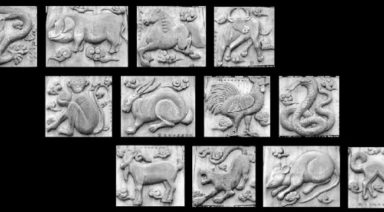Ramakrishna and Sarada Devi: Spiritual Ecstasy, Love and Vedanta

Sri Ramakrishna and Sarada Devi lived together in the 1800s as married awakened masters, although Sarada Devi rarely used language that portrayed herself in this way. Throughout her life, she was a devoted wife, disciple, and chaste nun.
After immersing himself in the traditions, teachings, and practices of many religions, Ramakrishna Paramahansa grew to worship the Divine Mother. Soon into their union, Ramakrishna would regard Sri Sarada Devi as an incarnation of The Divine Mother. He regularly addressed her as “Holy Mother.”
Both of these Indian guru-mystics were deeply committed saints in service to humanity. It’s quite rare when two enlightened souls find each other so early in their lives and then co-create a unified, congruent mission.
Upon moving into their home together, Ramakrishna asked Ma Sarada Devi if she came to distract him from his Godly life and pull him into the world of Maya. Sarada Devi responded, “No, I am here to help you realize your Chosen Ideal.”
“One must have devotion towards one’s own guru. Whatever may be the nature of the guru, the disciple gets salvation by dint of his unflinching devotion towards his guru.”
— Sarada Devi
Ramakrishna
Ramakrishna Paramahansa (1836-1886) was born in Gadadhar Chatterjee, India. From early boyhood, he experienced profound spiritual gifts and ecstasies. To facilitate and broaden his understanding of his beliefs and experiences, Ramakrishna pursued several religious traditions, including a devotion to the goddess Kali. He was also a student of Advaita Vedanta, Tantra (Shaktism) and Vaishnava (bhakti yoga).
Ramakrishna was eternally devoted to God, and his teachings spread like wildfire. As a native of Bengal, Ramakrishna attracted many of the Bengalese elites, which led to the creation of The Ramakrishna Math and The Ramakrishna Mission by one of his most devoted disciples, Swami Vivekananda.
Deeply committed to the eternal nature of all religious and spiritual disciplines, Ramakrishna studied Christianity for three days, during which he saw himself merge with Jesus. When he adopted Islam for three days, he experienced himself joining with Mohammad.
When he embraced a new tradition or religion, he would fully submerge himself and become one with its master. It’s because of these experiences and this intensity of focus that Ramakrishna believed that all paths lead to the eternal flame.
Sarada Devi
Born in Joyrambati, India, Sarada Devi (1853-1920) was Ramakrishna’s wife and spiritual partner. Often called Sri Sarada Devi or Sri Sri Maa, she was widely known as The Holy Mother, most especially to the devotees in the Sri Ramakrishna Monastic Order at the Ramakrishna Monastery.

Sarada Devi courtesy vedanta.org
Sri Sri Sarada Devi was a profoundly loving soul who played a vital role in the Ramakrishna movement and the sharing of her husband’s teachings.
Sarada Devi was an inspiration to thousands of men and women, encouraging future generations of women to choose lives focused on God. Sri Sri Maa is believed to have been an incarnation of The Divine Mother.
“If you want peace of mind, do not find fault with others. Rather learn to see your own faults. Make the whole world your own. No one is a stranger, my child; this is your own.”
— Sri Sri Maa
Ramakrishna and Sarada Devi Together
These two divine souls were married when Sri Sri Maa was only five years old. They began sharing a household when she was in her late teens. What began as Ramakrishna Math and Sarada Math, the collective mission came to be called, “Sri Ramakrishna Sarada Math,” which includes monastic orders for men and women, along with a philanthropic mission.
Because Sarada Devi was a householder who lived with bickering relatives, she became a vital and relatable confidant to many of the householder-followers of Ramakrishna.
Ramakrishna and Sarada Devi lived a monastic, celibate life, focused solely on teaching Vedanta to their many followers. After Ramakrishna passed from this life, Ramakrishna’s devotees saw Sri Sri Maa as their eternal mother.
Vedanta is one of the six schools of Hindu philosophy. It translates to, “End of the Vedas.” The primary Vedanta texts are The Upanishads, The Brahma Sutras and the Bhagavad-Gita. The essential premise of Vedanta is simple: We are eternally connected with every living soul and physical reality. There is no duality or separation because creation consists of one great, eternal fabric.
Ramakrishna Quotes
Ramakrishna was dedicated to the eternal nature of the divine. Every breath was a prayer. Here are some of his most alluring quotes:
“As long as I live, so long do I learn.”
“God is in all men, but all men are not in God; that is why we suffer.”
“Only two kinds of people can attain self-knowledge: those who are not encumbered at all with learning, that is to say, whose minds are not over-crowded with thoughts borrowed from others; and those who, after studying all the scriptures and sciences, have come to realize that they know nothing.”
“The Man who works for others, without any selfish motive, really does good to himself.”
“You see many stars in the sky at night, but not when the sun rises. Can you, therefore, say that there are no stars in the heavens during the day? Because you cannot find God in the days of your ignorance, say not that there is no God.”

Ramakrishna courtesy vendanta.org
“The winds of God’s grace are always blowing; it is for us to raise our sails.”
“You speak of doing good to the world. Is the world such a small thing? And who are you, pray, to do good to the world? First, realize God, see Him by means of spiritual discipline. If He imparts power, you can do good to others; otherwise not.”
“God has made different religions to suit different aspirants, times, and countries. All doctrines are only so many paths, but a path is by no means God himself. Indeed, one can reach God if one follows any of the paths with whole-hearted devotion…One may eat a cake with icing either straight or sidewise. It will taste sweet either way.”
Sarada Devi Quotes
Sri Sri Maa was a profound soul who had a deep understanding of Vedanta, and therefore a deep love for her devotees. Here are a few quotes to keep your soul inspired:
“There is no treasure equal to contentment and no virtue equal to fortitude.”
“Open your grief-stricken heart to the Lord. Weep and sincerely pray, ‘O Lord, draw me towards You; give me peace of mind.’ By doing so constantly, you will gradually attain peace of mind.”
“Desire may be compared to a minute seed. It is like a big banyan tree growing out of a seed, which is no bigger than a dot.”
“In the course of time, one does not feel even the existence of God. After attaining enlightenment, one sees that gods and deities are all Maya.”
“However strong or beautiful this body may be, its culmination is in those three pounds of ashes. And still, people are so attached to it. Glory be to God.”
Ramakrishna’s Final Days
Up until the moment of his death, Ramakrishna’s divine personality continued to draw a wide variety of devotees. They came from all walks of life, and a long list of races, creeds, religions, and nationalities. Christians, Muslims, agnostics, atheists, humanists, Hindus, Sikhs, devotees of other deities, and men and women from all ages flocked to his side with devotion.
No matter where disciples came from, when they were in Ramakrishna’s presence, they became purer. When in his company, a sinner could spontaneously become a saint.
In his final days, Ramakrishna suffered from throat cancer. During this time, he was nurtured by his disciples, including Sri Sri Maa. Moments before his death, Ramakrishna transferred all of his divine gifts to Swami Vivekananda.
Near the end of his life, Ramakrishna asked that Swami continue his teachings, and he requested that all of his disciples look to Vivekananda as their leader. At an old house near the river Ganges, the Ramakrishna Order of monastics began under the direction of Swami Vivekananda.
Sarada Devi’s Final Moments
Conscious of her divine nature, yet rarely expressing it, Sarada Devi was known for her kindness, motherly care, and ability to help her disciples find peace in their hearts. She continued her compassionate work until her health began to decline.
With her devotees gathered around her, Sri Sri Maa said, “But I tell you one thing—if you want peace of mind, do not find fault with others. Rather see your own faults. Learn to make the whole world your own. No one is a stranger my child: this whole world is your own!”
Both Sarada Devi and Ramakrishna were cremated on opposite sides of the River Ganges. Their monastic lives, missions, and eternal ideals continue to inspire hearts to bow at the feet of The Divine Mother.
“Practice meditation, and by and by your mind will be so calm and fixed that you will find it hard to keep away from meditation.”
— Sarada Devi
This article is part of a series on saints and gurus — for more click here.
Sri Anandamayi Ma: The Perfect, Profound and Mysterious Flower

When asked why she was in this world, Sri Anandamayi Ma said, “In this world? I am not anywhere. I am myself reposing within myself.”
An astrologer, Abinush Babu, once had the honor of reading Sri Ma’s palms. He said that her markings were beyond a defined deity or tradition, and “beyond the control of the invisible.” He went on to say that Kali would return to workshop her.
Every soul who visited Sri Ma was struck by her sweet but aloof tranquility, and her remarkable depth of presence. It was as if she did not only sway with the wind but was the wind itself.
There seemed to be no distilling the identity and physical form of Sri Ma from the nature-form of the universe. She appeared to be within all eternal fabrics, and beyond space and time. First-hand accounts state that when seated with Sri Ma, it felt as if you were sitting on the edge of forever.
“Ma is here. What is there to worry about?”
— Anandamayi Ma





































